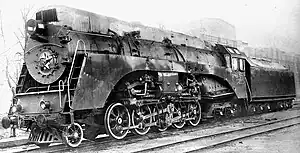
The Soviet-built opposed piston 2-10-4 locomotive
Built in 1949, the opposed-piston 2-10-4 was one of a number of Soviet locomotive designs that was unsuccessful. The cylinders were placed above the center driving axle. Unlike nearly all steam locomotives, the pistons had rods on both ends which transferred power to the wheels. The idea was to balance the driving forces on the wheels, allowing the counterweights on the wheels to be smaller and reducing "hammer blow" on the track. The locomotive was never repeated and the design was a failure. The locomotive was never used for more than testing and was returned to its builder, the Voroshilovgrad Works, and scrapped sometime afterward.
See also
External links
- Russian Reforms - Describes this and other Russian locomotive types
This article is issued from Wikipedia. The text is licensed under Creative Commons - Attribution - Sharealike. Additional terms may apply for the media files.